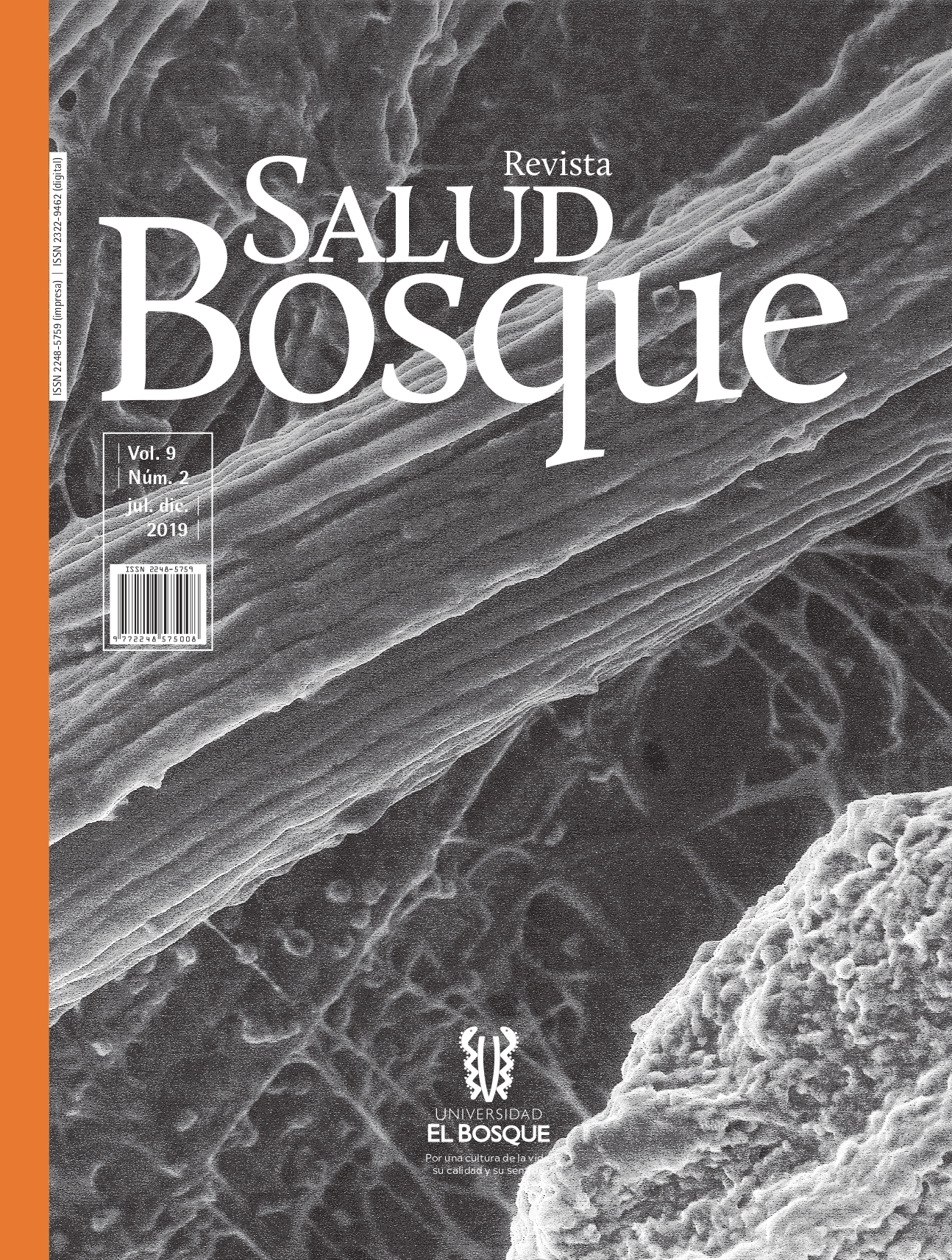Ketamine for analgesia of lumbosacral plexopathy secondary to the repair of an abdominal aortic aneurysm
DOI:
https://doi.org/10.18270/rsb.v9i2.2812Keywords:
Aneurysm, Ischemic, Polyneuropathy, Pain, KetamineAbstract
Introduction. Acute postoperative pain after abdominal aortic aneurysm is of high intensity; intraoperative complications may occur that increase nociception. Although opioids are the basis of analgesic treatment, their use is limited by the risk of respiratory depression and its potential for abuse. Ketamine is an option that provides analgesia and decreases the use of opioids.
Case presentation. 62-year-old male patient with abdominal aortic aneurysm who underwent endovascular and open repair. In the postoperative period he developed contralateral distal embolism with severe pain in the right buttock that required the stent explant and new revascularization. The pain was described as severe, incidental, with plantar allodynia, decreased proprioception and absence of pulses; electromyography reported moderate to severe axonal polyneuropathy with asymmetric compromise suggestive of plexus injury.
Discussion. Bilateral lumbosacral plexus ischemia was suspected, and ketamine was started (bolus = 1mg / kg plus infusion 0.5 mg / kg / hour), with significant improvement.
Conclusion. multimodal analgesia with ketamine is useful for postoperative analgesia in abdominal aneurysm repair surgery with improved analgesia and reduced opioid requirements.
Downloads
References
Bushby N, Wickramasinghe SY, Wickramasinghe DN. Lumbosacral plexopathy due to a rupture of a common Iliac artery aneurysm. Emerg Med Australas. 2010;22(4):351-3. DOI: 10.1111/j.1742-6723.2010.01310.x.
Brejt N, Berry J, Nisbet A, Bloomfield D, Burkill G. Pelvic radiculopathies, lumbosacral plexopathies, and neuropathies in oncologic disease: a multidisciplinary approach to a diagnostic challenge. Cancer Imaging. 2013;13(4):591-601. DOI: 10.1102/1470-7330.2013.0052.
Gardiner MD, Mangwani J, Williams WW. Aneurysm of the common iliac artery presenting as a lumbosacral plexopathy. J Bone Joint Surg Br. 2006;88(11):1524-6. DOI: 10.1302/0301-620X.88B11.17745.
Dyck PJ, Thaisetthawatkul P. Lumbosacral Plexopathy. Continuum: Lifelong Learning in Neurology. 2014;20(5):1343-58. DOI: 10.1212/01.CON.0000455877.60932.d3.
Chhetri S, Lekwuwa G, Seriki D, Majeed T. Acute flaccid paraparesis secondary to bilateral ischaemic lumbosacral plexopathy. QJM. 2013;106(5):463-5. DOI: 10.1093/qjmed/hct035.
Abdellaoui A, West NJ, Tomlinson MA, Thomas MH, Browning N. Lower limb paralysis from ischaemic neuropathy of the lumbosacral plexus following aorto-iliac procedures. Interact Cardiovasc Thorac Surg. 2007;6(4):501-2. DOI: 10.1510/icvts.2007.151993.
Deylgat B, Wallaert P, De Smul G, Van Lysebeth L, Ceuppens H. Unilateral Lower Limb Paralysis After Aortobifemoral Bypass Graft for Ruptured Abdominal Aortic Aneurysm: A Case Report. Vasc Endovascular Surg. 2009;43(6):606-9. DOI: 10.1177/1538574409345032.
Maddock MJ, Modi S, Nicholl P, Wee B. Lumbar Sacral Plexopathy—A Rare and Late Complication of Endovascular Aneurysm Repair. J Vasc Interv Radiol. 2013;24(3):448-9. DOI: 10.1016/j.jvir.2012.12.012.
Schreuder AH, Fennis TF, Teijink JA, Koehler PJ. Lumbosacral plexopathy associated with aortoiliac occlusive disease. J Neurol. 2007;254(6):803-5. DOI: 10.1007/s00415-006-0421-7.
Wider C, Kuntzer T, Von Segesser LK, Qanadli SD, Bogousslavsky J, Vingerhoets F. Bilateral compressive lumbosacral plexopathy due to internal iliac artery aneurysms. J Neurol. 2006;253(6):809-10. DOI: 10.1007/s00415-006-0083-5.
Planner AC, Donaghy M, Moore NR. Causes of lumbosacral plexopathy. Clin Radiol. 2006;61(12):987-95. DOI: 10.1016/j.crad.2006.04.018.
Özkavukcu E, Çayli E, Yaǧci C, Erden I. Ruptured iliac aneurysm presenting as lumbosacral plexopathy. Diagn Interv Radiol. 2008;14(1):26-8.
Gloviczki P, Cross SA, Stanson AW, Carmichael SW, Bower TC, Pairolero PC, et al. Ischemic injury to the spinal cord or lumbosacral plexus after aorto-iliac reconstruction. Am J Surg. 1991;162(2):131-6. DOI: 10.1016/0002-9610(91)90174-c.
Abdelhamid MF, Sandler B, Awad RW. Ischaemic lumbosacral plexopathy following aorto-iliac bypass graft: case report and review of literature. Ann R Coll Surg Engl. 2007;89(5):W12-3. DOI: 10.1308/147870807X188470.
Radvansky BM, Puri S, Sifonios AN, Eloy JD, Le V. Ketamine-a narrative review of its uses in medicine. Am J Ther. 2016;23(6):e1414-26. DOI: 10.1097/MJT.0000000000000257.
Kim H, Kang SH, Kim DK, Seo KM, Kim TJ, Hong J. Bilateral ischemic lumbosacral plexopathy from chronic aortoiliac occlusion presenting with progressive paraplegia. J Vasc Surg. 2014;59(1):241-3. DOI: 10.1016/j.jvs.2013.04.008.
Erstad BL, Patanwala AE. Ketamine for analgosedation in critically ill patients. J Crit Care. 2016;35:145-9. DOI: 10.1016/j.jcrc.2016.05.016.
Maher DP, Chen L, Mao J. Intravenous ketamine infusions for neuropathic pain management: A promising therapy in need of optimization. Anesth Analg. 2017;124(2):661-74. DOI: 10.1213/ANE.0000000000001787.
Schwenk ES, Viscusi E, Buvanendran A, Hurley RW, Wasan AD, Narouze S, et al. Consensus guidelines on the use of intravenous ketamine infusions for acute pain managment from the American Society of Regional Anesthesia and Pain Medicina, the American Academy of Pain Medicine, and the American Society of Anesthesiologists. Reg Anesth Pain Med.2018;43(5):456-66. DOI: 10.1097/AAP.0000000000000806.
Downloads
Published
How to Cite
Issue
Section
License

This work is licensed under a Creative Commons Attribution-NonCommercial 4.0 International License.
The authors will submit a statement attesting to the authenticity of the material, attaching signature and id number. It is also required that they submit a statement surrendering economic rights to El Bosque University










